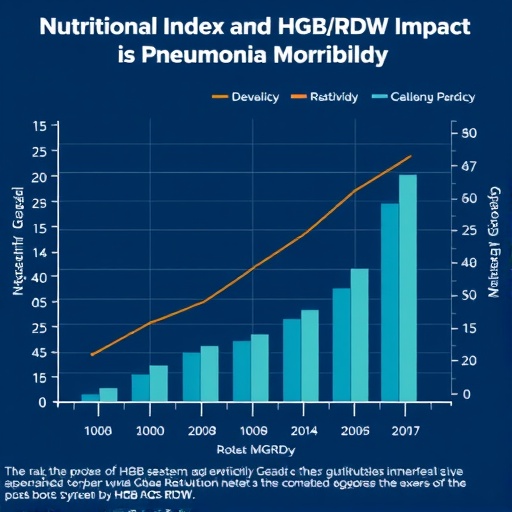The intertwined relationship between nutrition and health outcomes in children, especially during hospitalization for illnesses such as pneumonia, has garnered increasing attention in the medical community. A recent study by Cay and Aycan highlights a critical aspect of this issue by examining the prognostic nutritional index (PNI) and hemoglobin/red cell distribution width (hgb/rdw) levels in the context of pneumonia morbidity among young patients. This noteworthy research not only elucidates the significance of nutritional status but also offers insights that could shape future therapeutic approaches aimed at improving pediatric healthcare.
Pneumonia remains a leading cause of morbidity and mortality in children worldwide, often necessitating hospitalization for those affected severely. Children with this respiratory infection typically require a comprehensive management approach, which spans beyond just the immediate medical treatment. For pediatric patients, the integration of nutritional assessments into clinical protocols may be as important as antibiotic therapies. Cay and Aycan propose that understanding nutritional indices could be vital in determining both the immediate care strategies and long-term health outcomes for these young patients.
The prognostic nutritional index (PNI), a measure derived from serum albumin levels and total lymphocyte count, serves as an important biomarker that reflects the nutritional status and immune competence of individuals. In their study, the authors found that a lower PNI was significantly correlated with adverse outcomes in children hospitalized with pneumonia. This correlation illustrates a broader trend observed in pediatric medicine: nutrition plays a pivotal role in recovery and the management of infections. Ensuring that children are adequately nourished can potentially mitigate the severity of their condition and speed up their recovery process.
Additionally, the study examined hgb/rdw levels as a complementary measure of nutritional and health status. Hemoglobin levels, coupled with the red cell distribution width, can provide insights into a child’s underlying health and can indicate the presence of anemia or other systemic issues. The authors argue that monitoring these parameters can be crucial in the early identification of at-risk pediatric patients. Anemia, for instance, can complicate pneumonia and other infections, emphasizing the need for a holistic approach to treatment that includes addressing nutritional deficiencies.
Cay and Aycan’s findings resonate with the current push in healthcare to prioritize personalized medicine, where treatment regimens are tailored according to the individual needs of patients based on comprehensive assessments. By identifying specific nutritional needs and potential deficiencies, medical professionals can create more effective health management plans that not only address the respiratory condition at hand but also enhance overall health and resilience against future infections.
Furthermore, the implications of this research extend beyond individual treatment paradigms. A greater focus on nutritional status in pediatric care may drive systemic changes in healthcare protocols, influencing policy and practice at various institutional levels. For instance, hospitals could implement routine nutritional screening for all pediatric patients upon admission, particularly those diagnosed with respiratory illnesses. Such measures could facilitate timely interventions, ultimately reducing the length of stay and the incidence of complications.
The relationship between nutrition and immune function exemplified in this study aligns with broader epidemiological findings that underscore the importance of nutrition in childhood development. Malnutrition, whether through undernourishment or overnourishment, can have long-term effects on children’s health, impacting their ability to fight infections, recover from illness, and grow optimally. Addressing nutritional gaps in children could not only improve outcomes for pneumonia but could also play a significant role in combating the prevalence of chronic diseases later in life.
As the research community continues to explore the multifactorial dimensions of pneumonia in children, studies like those conducted by Cay and Aycan serve as a clarion call for increased research in this area. The integration of nutritional assessment into standard care practices may pave the way for breakthroughs that enhance recovery rates and reduce morbidity in pediatric pneumonia cases. It emphasizes the necessity for cross-disciplinary collaboration among pediatricians, nutritionists, and researchers to foster a more robust understanding of the interplay between nutrition and recovery from respiratory infections.
Moreover, the study’s findings are bolstered by robust statistical analysis, further affirming the reliability of their conclusions. Such rigor lends credence to the call for broader application of nutritional indices in pediatric healthcare settings. Clinical trials could be aimed at determining optimal nutritional interventions tailored to various demographics, exploring how different diets or supplementation might influence recovery times and overall health outcomes.
As more pediatric care facilities embrace this integrated approach, there is hope for a transformation in how children with pneumonia—or any illness, for that matter—are treated. Beyond immediate care, fostering a culture that prioritizes nutrition as a fundamental component of health will ultimately enrich the quality of care delivered to children, curbing the relentless cycle of illness and recovery that defines many young lives.
In conclusion, the dual focus on the prognostic nutritional index and hgb/rdw levels provides a nuanced understanding of how nutritional status can influence morbidity in pediatric pneumonia cases. Cay and Aycan’s research not only sheds light on the critical importance of these parameters but also serves as a stepping stone toward developing comprehensive healthcare strategies that encompass nutritional well-being as a cornerstone of pediatric medicine. As we look to the future of healthcare, let us collectively strive to incorporate these findings into practice, ensuring that the next generation of children is not only treated for sickness but also nurtured toward optimal health.
Subject of Research: The effect of prognostic nutritional index and hemoglobin/red cell distribution width level on morbidity in children with pneumonia.
Article Title: The effect of prognostic nutritional index and hgb/rdw level on morbidity in children with pneumonia.
Article References:
Cay, O.O., Aycan, O.K. The effect of prognostic nutritional index and hgb/rdw level on morbidity in children with pneumonia. BMC Pediatr 25, 777 (2025). https://doi.org/10.1186/s12887-025-06087-5
Image Credits: AI Generated
DOI: 10.1186/s12887-025-06087-5
Keywords: Prognostic nutritional index, hgb/rdw, pneumonia, pediatric morbidity, nutrition and health.




